“Essentially, all life depends on the soil … There can be no life without soil and no soil without life; they have evolved together.” (USDA, 1938)
These words, written by the soil scientist Charles Edwin Kellog in the first decades of the 19th century – there is no doubt – are weightly. But we still not yet care about the soil. We even don`t know, which broad biodiversity exists beneath our feet.
„The number of microorganisms in a teaspoon of soil is (1 × 109). The fraction of microbial diversity that we have sampled to date is effectively zero (cf. Microbiology by numbers, 2011)“. More than 95% of soil microbial species are non-culturable, but metagenomic analysis of nucleic acids is transforming our ability to understand the breadth and diversity of soil microbial communities and their functional capabilities (cf. Gupta, 1997). That this hidden world is non-culturable is the reason, why it`s often referred to as „microbial dark matter“.
The misunderstood species
The global soil biodiversity initiative wants to adjust by presenting an online atlas (Fig. 01), which tries to synthezise global soil biodiversity research and its importance to the living world (Orgiazzi, A et. al. 2016). Showing pictures of the foreign invisible worlds is important, as many people feel strange and uncomfortable with microbiota – quite wrongly labelled, because human pathogens account for much less than 1% of the total number of microbial species on the planet (Microbiology by numbers, 2011). Media like the german tv show „VISITE“ which describe microbiota in the garden compost as dangerous for causing life-threatening infections help to transport these framings.
Interesting in this context are the concepts of framing and attribution, which (Goffmann, 1974) introduced in his Book „Frame Analysis“. He found, people try to organize their experiences by attribution of interpretations and meanings. These contextual frames are shared through communication media in society and generate common interpretation schemes. Frames help to locate, percieve, identify and label. The frameworks provided by media often are adopted from reciepients without questioning it. As Goffman stated: „The type of framework we employ provides a way of describing the event to which it is applied“. Once established, a frame system is difficult to break up.
A completely different labelling is attributed by (Coleman et. al. 2018). The biologists describe detrital food webs with its complex interactions as basic functions to provide ecosystem services such as fostering nutrient cycling, ecosystem stability and long-term carbon balance. Other academic work points out, that the functional capacity of the plant microbiome is not equal to the sum of its individual components, since microbial species strongly and frequently interact with each other and form a complex network (van der Heijden, 2016). These networks can be visualized by calculating correlations between the abundance of individual entities. Latest studies will engage, answering the question aided by machine learning and network research methods, whether microbiome functioning depends on organization, complexity and interconnectivity of microbial networks. The example of (Connor, 2016) shows a small microbiome network and its interconnections (fig. 02). Unfortunately the biologists framing occurs merely in the media world.

Fig. 02: Example for a small microbiome network and it`s interconnections by Connor, 2016
Interconnected and crucial: what microbiome networks teach us
„The ecosystem services approach looks at the environment from an angle of the benefits people obtain from ecosystems. These include provisioning services such as food, water, timber, and fiber regulating services that affect climate, floods, disease, wastes, and water quality; cultural services that provide recreational, aesthetic, and spiritual benefits; and supporting services such as soil formation, photosynthesis, and nutrient cycling. The human species, while buffered against environmental changes by culture and technology, is fundamentally dependent on the flow of ecosystem services.“ (Millenium Ecosystem Assessment, 2005)
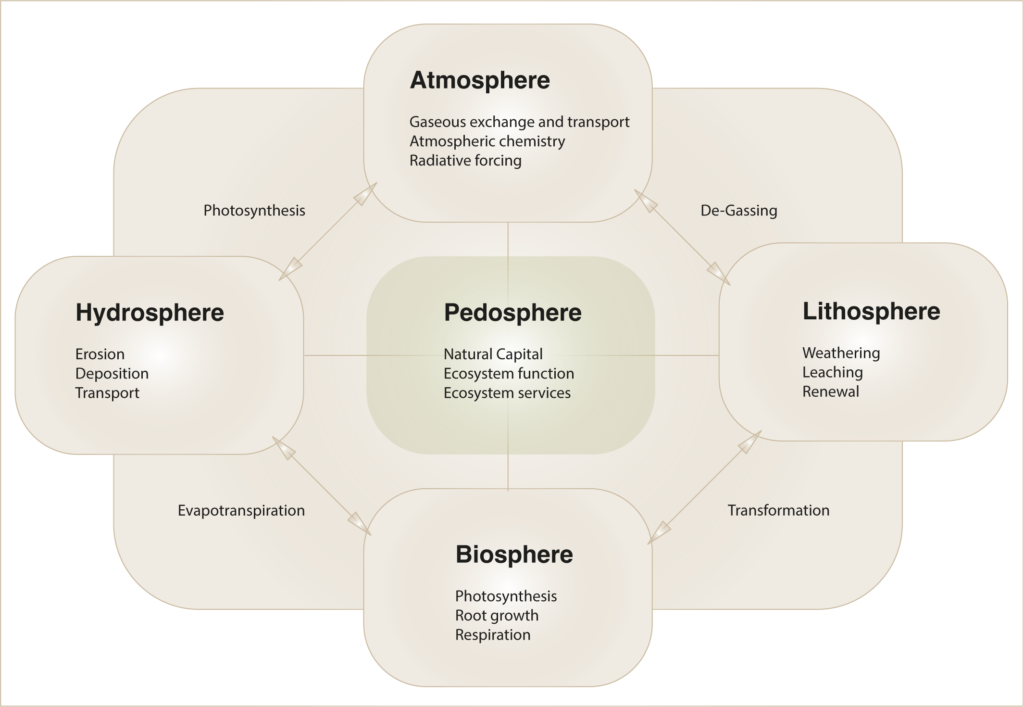
Fig. 03: Interactive pedospheric processes and their services, own work, contents taken from Lal, 2013.
Degraded soils with a lack of humus (and its associated species) would not provide enough ecosystem services any more. However, we couldn`t watch the microbial networks isolated from other systems and just concentrate on mitigation strategies when for example soil erosion leads to floodings or our groundwater get`s polluted by overfertilization. Across a whole ecosystem approach, the functioning of our basis of existence depends on interconnections between different spheres which are heavily to understand in their complexity. (Lal, 2013) adds to the four well known spheres of earth a new one, called pedosphere (fig. 03). As the outermost layer of the earth it functions as an intersection between the other spheres. The whole system could only work, if all involved spheres are healty and interconnections can run without malfunctions. Is one sphere misbalanced, the state of balance will be destroyed and all the other spheres get affected.
A holistic world view as a core objective for the new century
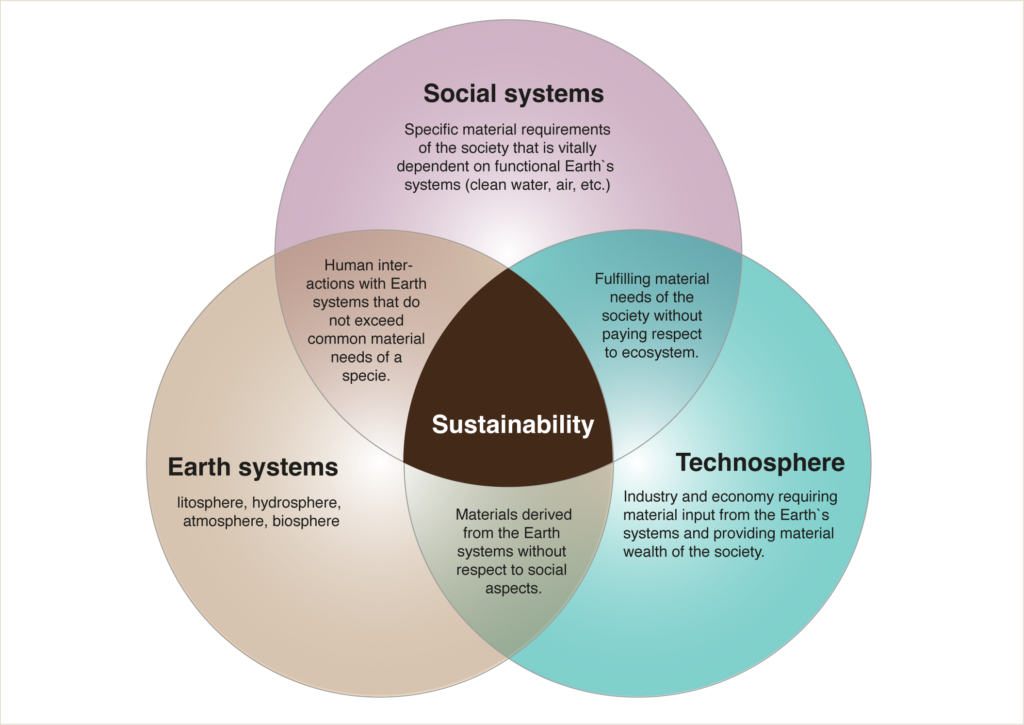
Fig. 04: Model of Sustainability. Own work, contents taken from (Prikryl et. al., 2016)
The concept of anthroposphere was elaborated by (Baccini & Brunner, 1996). It encompasses „our ownsphere of life“ and it`s metabolic processes. The relationships between Earth systems (fig. 04) and anthroposphere were shown by (Prikryl et. al., 2016). In their concept the anthroposphere is consisting of technosphere and of social systems. From this angle, we start gaining a small clue, what sustainability is affected by. As men we have a big responsibility and for that we should leave behind an ego centered world view, considering only mankinds needs.
A holistic view implicates that everyone has to practice active soil management. Instead of a dark matter, soil management as a crucial part of ecosystem must become a matter of course, which is harmonious embedded in our technospheres as well as our social systems. We all have to pay more respect to this hidden worlds. The humus layer, also referred to as topsoil, can reduce soil erosion and work as a carbon storage. It`s between ten and thirty centimeters deep. Depending on soil quality and kind of land usage the humus content in the topsoil differs (cf. Düwel 2007). It`s estimated, that soil organic matter consists 58 % of carbon (Doran, 2012).
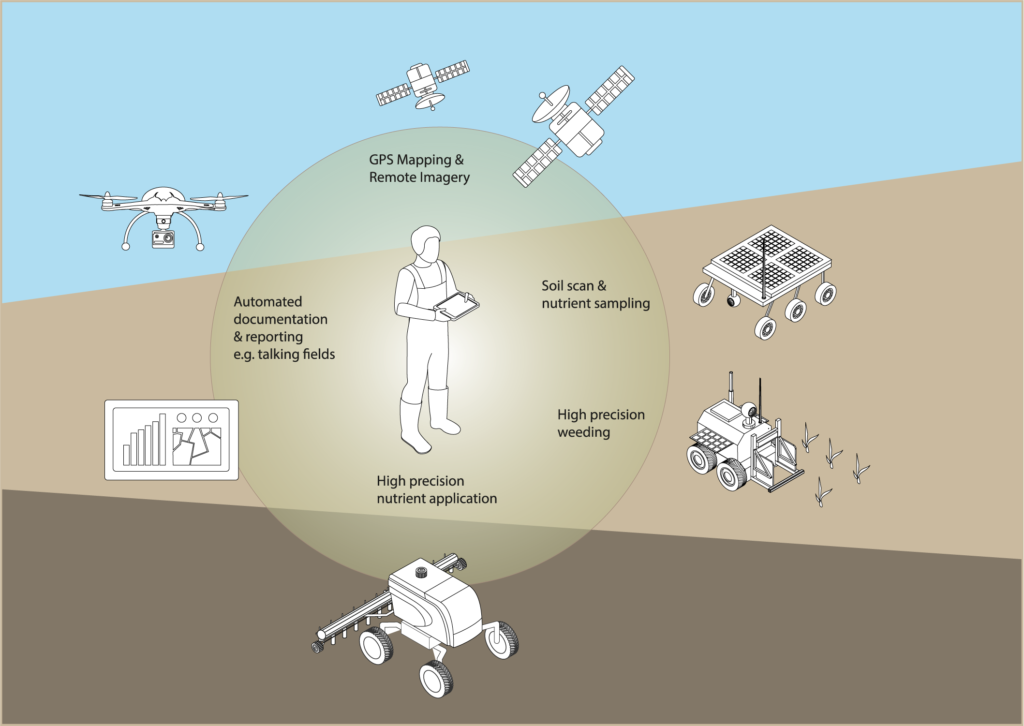
Fig. 05: Precision farming as an information product with advisory functions can help farmers by gaining precise data from satellite technology, connected roboting systems and sensors. Own work, inspired by a talk from Prof. Dr. Peter Pickel at Hülsenberger Gespräche, 2018
Sustainable soil management with precision farming systems
Effective land use would not be avoidable, but to gain or to obtain a climate smart soil biodiversity it`s crucial to understand how to manage and protect this dark and secretive world. Important target groups for active soil management are land owners, e.g. the farmers. Precision farming could be a chance to bring us a decisive step closer towards achieving these targets. (Gupta, 1997) explains conservation agriculture (CA) as a kind of land management, where food webs and trophic levels are intact and the biodiversity of microorganisms is high. It has four basic elements: reduced or no-tillage; retention of plant/crop residues; diverse rotations; and precision agriculture including controlled traffic. Each of these elements greatly impact soil microbial communities, their function and system productivity.
Precision farming, (Bach & Mauser, 2018) find, is an important step towards sustainable agriculture. Talking fields e.g. are information products with different analysis functions like yield potential maps or biomass maps. The monitoring system gives farmers the possibility to react accurately with sitespecific farming techniques and also satisfy foreseeable future needs. Combining earth observation and navigation satellites input with information from ground sensors (provided by roboters, drones or fixed devices), allows to analyze correlations between different indicators: crop types, biomass development, current growth status, development of the cultivated crop, water holding capacity, soil properties, yield or nitrogen uptake and many more. In-field differences can be displayed and considered, an achievement which facilitates exact fit fertilization. Precision Farming leads to lower production costs, as resources such as water, seeds and fertilizer are not wasted. Sustainability can be
succeded. Less fertilizer is leached to the ground water, what prevents from overfertilization.
Obstacles to the realization of sustainability goals in technosphere
Precision farming to gain more sustaniability would be a great idea. Wouldn`t it? Looking at the media, there are indicators that the framing of the discussion has a different direction. Using a monitoring tool which provides information analysis across sources and media channels, a web search was implemented by the author of this article (fig. 06). The monitoring encompassed web entries from the whole globe. It ran from 27 February 2021 to 27 March 2021. Two searches were created. The first extracted all entries in which the terms „precision farming“ and „profit“ simultaneous occured, the other showed occurences of the terms „precision farming“ and „rural development“. The profit-nexus had 355 entries while the rural-development or service-nexus only had 65 entries. Searches with similar terms, like „precision farming / ecosystem service“ came to compareable outomes. This points out first indications, that the worldwide discussion is mainly driven by a profit-nexus. More findings are necessary to confirm, but at a first step the question raises: Could profit-nexus in Precision Farming be a worldwide framing?
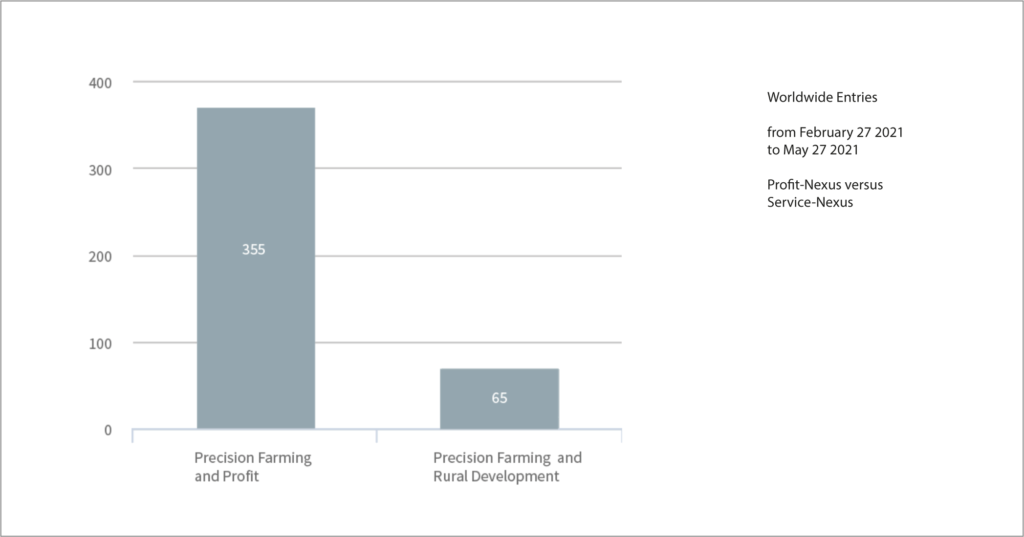
Fig. 06: Own work aided by the web monitoring tool Ubermetrics. Worldwide web entries from 27 February 2021 to 27 March 2021 in which the terms „precision farming / profit“ and „precision farming / rural development“ simultaneous occured.
If we`ll attribute precision farming in our heads with profit and even don`t have a clue, how it can foster ecosystem services and rural development, where would this lead to? What would happen, when these powerful new technologies are used mainly in a profit oriented way? This would reinforce the worldwide tendency of exploiting natural resources, with aid of the new technologies much more strongly than ever before.
Reframing from profit-nexus to service-nexus: outcomes still remain open
„The challenge of reversing the degradation of ecosystems while meeting increasing demands for their services can be partially met under some scenarios that the MA has considered, but these involve significant changes in policies, institutions, and practices that are not currently under way.“ (Millennium Ecosystem Assessment, 2005)
Since many years the EU tries setting up sustainable development goals (fig. 07), but it`s difficult to bring concepts dealing with sustainablity into practice. The factual grounds remaining undifferentiated. On the one hand it`s not to deny that the subsidies of the EU are payed per hectare, what leads to increasing yields for the big farming industries and exploitative land use, while small farms more and more dissappear. On the other hand, the different countries don`t embed the goals of the Common Agricultural Policies (CAP) into their political programmes, what could be an indicator, that the service-nexus hasn`t come up in both the communication media and the political landscape.
It`s not enough to set goals. Also the Federal Constitutional Court of Germany endorses this statement and allows an appeal of young climate activists from the friday for future movement in april 2021. The environmental campaigners had called attention to the fact, that there are no mandatory stipulations which can lead to a quantifiable reduction of greenhouse gases within the German climate protection law. (Bundesverfassungsgericht, 2021)
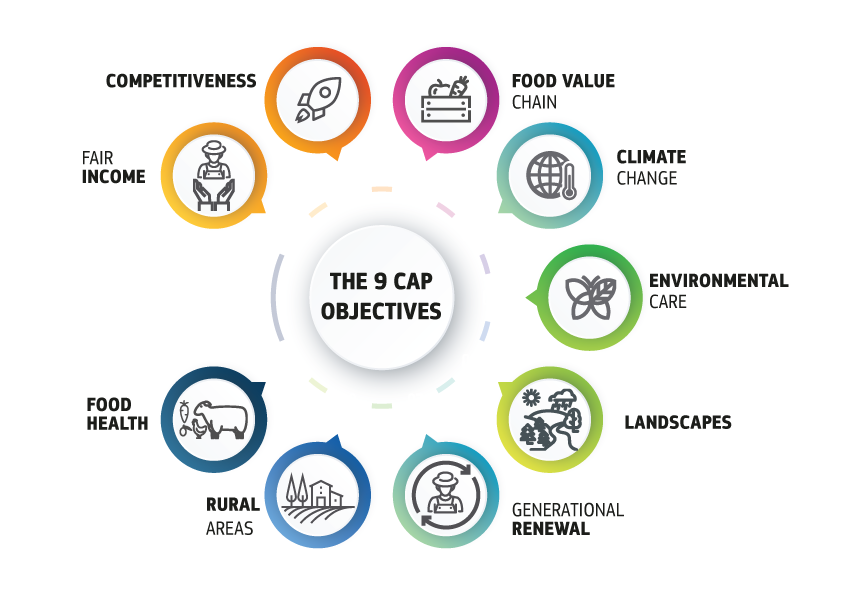
Fig. 07: The nine key objectives of the CAP. https://ec.europa.eu/info/food-farming-fisheries/key-policies/common-agricultural-policy/new-cap-2023-27/key-policy-objectives-new-cap_en
As Millennium Ecosystem Ascomesessment already in the year 2005 critizied, face existinginstitutions significant barriers. More cooperation across sectors will be necessary. Intensified attention to transparency and accountability of government and private sector, paired with increased coordination, are crucial to make changes. If institutions and parliaments of the EU and their member states don`t make any movement or stay in vague formulations, improvements will also the next years remain a dream of the future. The following steps could lead to a more ecosystem friendly agriculture:
- elimination of subsidies that promote excessive use of ecosystem services (and, where possible, transfer of these subsidies to payments for nonmarketed ecosystem services)
- precision farming concepts with computer applications and satellite systems, which are not from the private sector but institutional provided
- revised political programmes, which are tailored to the needs of the new technology and create measurable results for sustainable development.
To be at a loss will not help
Let`s roll up our sleeves and get started today. There is a lot to do. The soil under our feet is everywhere. We can take it in our hands. It`s tangible. It`s concrete. We can feel it`s structure and imagine the microbial networks inside. We can see if it`s dry and degaded or healthy and frutile. We just have to take care and gain knowledge about it.
But it seems like, that is to say, we have to deal with another kind of dark matter: our thinking and what it`s attributed to. To make a change in our own minds is much more difficult than fostering soil and plants. So let`s start with the easy part, growing new plants in pubic areas to enhance health of soil. Each plant, as a part of a grassroot movement, will have a common origin and meaning, reminds us what is of paramount importance: thinking about our own frames and recheck if they are still up to date.
References
Bach H., Mauser W. (2018) Sustainable Agriculture and Smart Farming. In: Mathieu PP., Aubrecht C. (eds) Earth Observation Open Science and Innovation. ISSI Scientific Report Series, vol 15. Springer, Cham. https://doi.org/10.1007/978-3-319-65633-5_12
Bader, H.P. Baccini, P. (1996). System-Modelle und Simulations-Programme im Umweltmanagement – Eine kritische Analyse zum Stand der Technik. Doi: https://doi.org/10.14512/gaia.5.6.3
Bundesverfassungsgericht. (2021, 29. April). Verfassungsbeschwerden gegen das Klimaschutzgesetz teilweise erfolgreich. https://www.bundesverfassungsgericht.de.
https://www.bundesverfassungsgericht.de/SharedDocs/Pressemitteilungen/DE/2021/bvg21-031.html
Coleman, D.C., Callaham, M.A., Crossley Jr, D. (2017). Fundamentals of Soil Ecology. Academic Press, London, United Kingdom. (14) (PDF) Fundamentals of Soil Ecology: Third Edition. https://www.researchgate.net/publication/321148966_Fundamentals_of_Soil_Ecology_Third_
Edition.
Connor, N. Barberán, A. & Clauset, A. (2016). Using null models to infer microbial co-occurrence networks, PLOS ONE doi: 10.1371/journal.pone.0176751
Doran, P. (2012). Bioprocess Engineering Principles. Academic Press.
Düwel, O. Siebner, C.S. Utermann, J. Krone, F. (2007). Gehalte an organischer Substanz in Oberböden Deutschlands. https://www.bgr.bund.de/DE/Themen/Boden/Produkte/Schriften/Downloads/Humusgehalte_Bericht.pdf
Goffman, E. (1974). Frame analysis: An essay on the organization of experience. Harvard University Press.
Gupta, V. Roper, M. & Thompson, J. (1997). Life in the Soil. Adelaide, Australia: Cooperative Research
Centre for Soil & Land Management. CSIRO, The University of Adelaide. p. 237 – 253.
https://cdn.csu.edu.au/__data/assets/pdf_file/0005/3246548/Australian-Agriculture-in-2020-Pt4Ch15.pdf
van der Heijden MGA, Hartmann M (2016). Networking in the Plant Microbiome. PLoS Biol 14(2):e1002378. https://doi.org/10.1371/journal.pbio.1002378
Kellog, C. E. (1938). Soils and Men, USDA, Yearbook of Agriculture, Washington DC
R. Lal, K. Lorenz, R. Hüttl, B. Schneider, J. Braun (2013). Ecosystem Services and Carbon Sequestration in the Biosphere. Springer Netherlands.
Microbiology by numbers. (2011, 12. August). Nature Reviews Microbiology.
https://www.nature.com/articles/nrmicro2644?error=cookies_not_supported&code=00f75292-59ea-4ac9-b0d8-8a9ece0bcb96
Millennium Ecosystem Assessment, 2005. Ecosystems and Human Well-being: Synthesis. Island Press, Washington, DC.
Orgiazzi, A., R.D. Bardgett, E. Barrios, V. Behan-Pelletier, M. J. I. Briones, J. L. Chotte, G. B. De
Deyn, P. Eggleton, N. Fierer, T. Fraser, K. Hedlund, S. Jeffrey, N. C. Johnson, A. Jones, E.
Kandeler, N. Kaneko, P. Lavelle, P. Lemanceau, L. Miko, L. Montanarella, F. M. de Souza
Moreira, K. S. Ramirez, S. Scheu, B. K. Singh, J. Six, W. H. van der Putten, and D. H. Wall.
(2016). Global Soil Biodiversity Atlas. European Commission, Publications Office of the
European Union, Luxembourg.
Prof. Dr. Peter Pickel at Hülsenberger Gespräche, 2018
Prikryl, R. Török, A. Gomez-Heraz, M. Miskovsky, K & Theodoridou, M. (2016).
VISITE – TV Programme NDR https://www.ndr.de/ratgeber/gesundheit/Gartenarbeit-Schwere-Infektionen-verhindern,garten1554.html

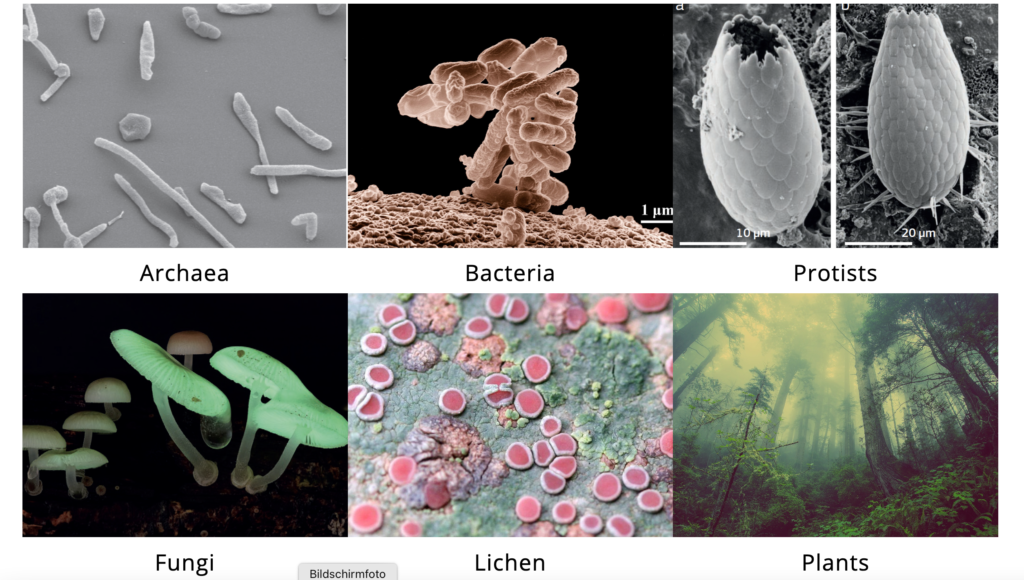
Pingback: Der Boden unter unseren Füßen: eine dunkle Materie - designeon